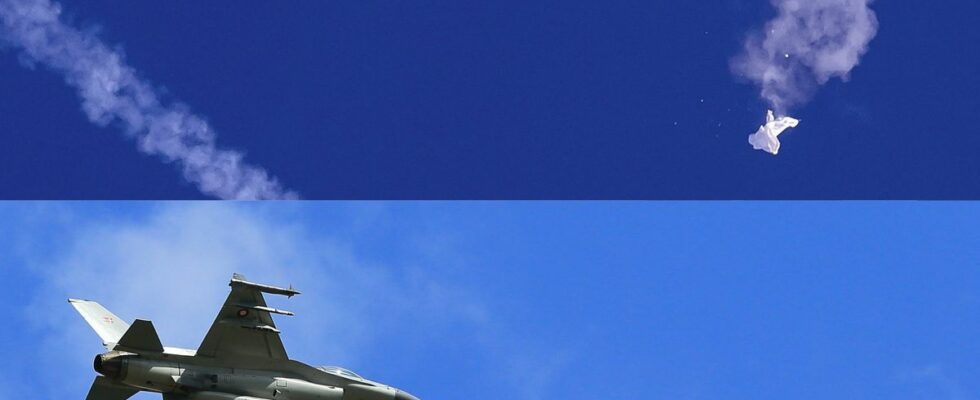Flying objects seem to be multiplying across the Atlantic. On February 2, a balloon flying at high altitude over the United States was spotted. It was shot down two days later, the Chinese object being considered by Washington as a “spy”. Then on February 10, a new flying object was shot down over Alaska, the next day another was destroyed in northwestern Canada and finally on Sunday a fourth was shot down by an F-16 over Lake Huron. , in the northern United States. But are these flying objects frequent? Why were they shot? 20 minutes provides an update on these mysterious hijackers thanks to the insight of Bertrand Vilmer, associate partner of Icare Groupa consulting firm specializing in aeronautics and a former experimental test pilot.
Are these unidentified flying objects frequent?
The airspace is lightly monitored above 20 kilometers, so it is difficult to know exactly what is there. “Radars have great difficulty picking up objects flying at very high altitudes, beyond 20 kilometers because they are designed to track the activity of airliners which never exceed 18,000 meters in height,” explains Bertrand Vilmer. Especially since between 20 kilometers and 100 kilometers high, there is a “form of regulatory and technical impunity”. Firstly regulatory, because above 20 kilometers altitude, “it’s no longer national airspace, there are no regulations” and technical because at this altitude, “nobody can see you or very difficult,” explains the aeronautical expert.
Still, spy balloons are nothing new in the field of intelligence. “What is new is that we have forgotten them. It was very common during the Cold War, both sides used hundreds of them for intelligence, ”recalls the former test pilot who admits, however, that it is a method” no longer so fashionable “. The method may be outdated, but it has definite advantages. While surveillance satellites – visual as well as electromagnetic – do not descend below 100 kilometers in height, spy balloons can get closer to the targets… which they spy on. “Because they are much lower, they get good images with less sophisticated optics. As for interception, in particular electromagnetic or radar, it is easier to obtain information at a height of 20 kilometers than at 100 or 200”, deciphers Bertrand Vilmer, who adds that they are much cheaper.
Why were these objects shot down?
Sixty meters high and weighing about a ton, the balloon shot down on February 4 was hard for Washington to ignore. Photographs taken by airplanes showed very characteristic antennae. “It was obvious that it was not a weather balloon, given the size of the antennas. They are made to intercept communications from the countries overflown, not to monitor the weather,” says Bertrand Vilmer. “The Americans shot it down because they were convinced it was a spy plane over their territory,” says the aeronautics expert. Especially since the balloon flew over Montana, where the Malmstrom Air Force Base is located, an American army base, nicknamed the “nuclear base of the apocalypse”. A highly sensitive site therefore.
Moreover, the presence of the ball having been fanned, it was politically difficult for Joe Biden to ignore it. “The Americans were forced to shoot it down for reasons of internal politics, of sovereignty”, abounds Bertrand Vilmer. The other devices detected and shot down were at an altitude of 12,000 meters for the first two and 6,000 meters for the last. They could therefore have represented a danger to the safety of civilian flights. In general, airliners travel between 5,100 and 12,200 meters. The objects were therefore knocked down in order to eliminate the risk of collision. They may also have been spotted thanks to the first incident. “Most of what we were looking for didn’t look like balloons. Now, of course, we are looking for them. So I think we’re finding more stuff,” Democratic House Intelligence Committee member Jim Himes, a member of the House Intelligence Committee, said on Sunday.
What consequences could this incident have on the relationship between Washington and Beijing?
The tension is palpable between Washington and Beijing since the balloon was spotted drifting over the United States. US Foreign Minister Antony Blinken has postponed a visit to China. On Friday, Washington added six Chinese companies to its blacklist, barring them from accessing US technology and goods without permission. And since the incident, the two countries return the ball. Beijing thus claims that since the beginning of 2022, American balloons have violated its airspace “more than ten times”. A possible theory, for Bertrand Vilmer, who recalls that certain flying objects “are part of extremely sensitive and confidential military programs with absolute compartmentalization”. It is therefore difficult to corroborate these accusations when, in these programs, “everyone only knows a small piece of the puzzle”.
Washington dismissed Beijing’s accusations on Monday, saying China was only trying to ‘damage control’ as it ‘violated the sovereignty of the United States and more than 40 countries’ with its ‘spy balloon program’ . After the balloon was shot down, Beijing expressed its “strong displeasure” and the foreign minister said the country reserved “the right” to retaliate. However, there is little chance that the estrangement will escalate. “No one has an interest in raising the sauce”, slips Bertrand Vilmer. Still, the atmosphere is cold between the two powers and their rivalry in the Pacific is not about to deflate.

